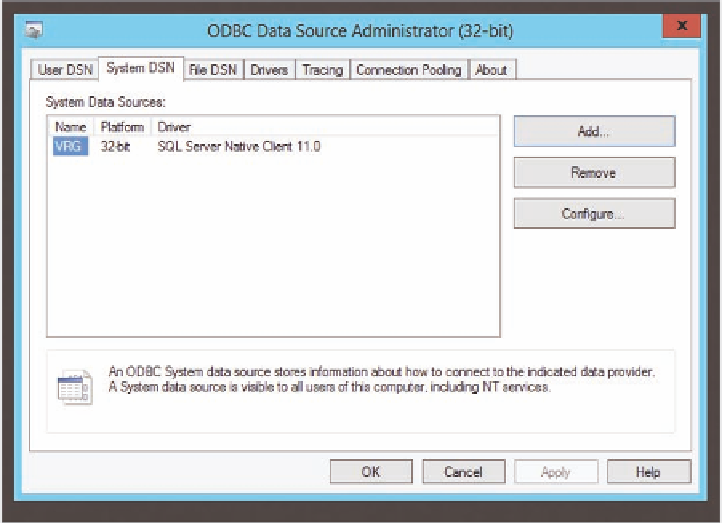Database Reference
In-Depth Information
The VRG system data
source
Figure 11-9
the Completed VrG System
Data Source
We will use the VRG DSN later in this chapter to process the SQL Server database created
in Chapter 10. Similarly, if you are using either the Oracle or MySQL DBMS, you should create
an appropriate system data source for use with your Oracle or MySQL version of the View
Ridge Gallery database.
The
.NET Framework
is Microsoft's comprehensive application development platform. Web
database applications tools are included in the .NET Framework. Originally released as the
.NET Framework 1.0 in January 2002, the current version is the .NET Framework 4.5.
As shown in Figure 11-10, the .NET Framework can best be visualized as a set of build-
ing blocks stacked on top of each other. Each additional block adds additional functionality
to the components already existing in previous blocks, and, if earlier components need to be
updated, this is done by service packs to the older blocks. Thus, .NET Framework 2.0 SP2 and
.NET Framework SP2 were included as part of .NET Framework 3.5 SP1, and upgrades to all
portions of the .NET Framework are included in .NET Framework 4.0 and .NET Framework 4.5.
Although Figure 11-10 does not show every feature of the .NET Framework 3.5 SP1, the
basic structure is easy to see. The .NET Framework 2.0 is now the basic layer and contains the
most basic features. These include the
Common Language Runtime (CLT)
and the
Base
Class Library
, which support all of the programming languages (e.g., VB.NET and Visual
C#.NET) used with the .NET Framework. This layer also includes the ADO.NET and ASP.NET
components, which are needed for Web database applications.
The .NET Framework 3.0 added a set of components that are not of interest to us here. We
are more concerned with the features added in .NET Framework 3.5 and 3.5 SP1, noting that
these features were upgraded, but not replaced, by .NET Framework 4.0. Note that several ex-
tensions to ADO.NET were included in .NET Framework 3.5 and 3.5 SP1, such as the
ADO.NET
Entity Framework
, which supports Microsoft's emerging
Entity Data Model (EDM)
data
modeling technology, as well as the
Language Integrated Query (LINQ)
component, which
allows SQL queries to be programmed directly into application programs in a simple manner.
Besides updating existing features, the .NET Framework 4.0 added features needed for par-
allel processing on clustered servers. These include
Parallel LINQ (PLINQ)
and
Task Parallel
Library (TPL)
, but these parallel processing features are beyond the scope of this topic.
The .NET Framework 4.5 again updated many existing features and added functionality for







Search WWH ::

Custom Search